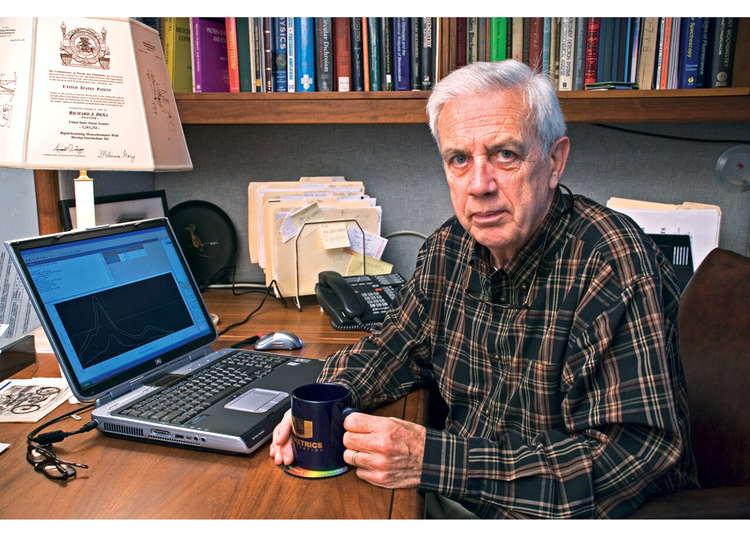Some Known Details About Uv/vis
Everything about Uv/vis
Table of ContentsNot known Incorrect Statements About Circularly Polarized Luminescence Excitement About SpectrophotometersWhat Does Uv/vis/nir Mean?The smart Trick of Uv/vis/nir That Nobody is Talking About5 Simple Techniques For Spectrophotometers

Spectrophotometry is a tool that hinges on the quantitative analysis of molecules depending on how much light is absorbed by colored compounds.
Uv/vis/nir - An Overview
A spectrophotometer is frequently used for the measurement of transmittance or reflectance of services, transparent or opaque solids, such as refined glass, or gases. Although many biochemicals are colored, as in, they take in noticeable light and for that reason can be measured by colorimetric procedures, even colorless biochemicals can typically be converted to colored substances appropriate for chromogenic color-forming reactions to yield substances suitable for colorimetric analysis.: 65 Nevertheless, they can likewise be created to determine the diffusivity on any of the listed light ranges that generally cover around 2002500 nm utilizing different controls and calibrations.
An example of an experiment in which spectrophotometry is utilized is the determination of the equilibrium constant of a solution. A certain chemical reaction within a service might happen in a forward and reverse instructions, where reactants form products and products break down into reactants. At some point, this chemical reaction will reach a point of balance called a balance point.
Things about Uv/vis/nir
The quantity of light that travels through the option is a sign of the concentration of particular chemicals that do not permit light to pass through. The absorption of light is due to the interaction of light with the electronic and vibrational modes of particles. Each kind of molecule has a specific set of energy levels related to the makeup of its chemical bonds and nuclei and hence will take in light of particular wavelengths, or energies, resulting in distinct spectral residential or commercial properties.
The usage of spectrophotometers spans different clinical fields, such as physics, products science, chemistry, biochemistry. circularly polarized luminescence, chemical engineering, and molecular biology. They are commonly utilized in numerous industries consisting of semiconductors, laser and optical manufacturing, printing and forensic examination, in addition to in laboratories for the research study of chemical substances. Spectrophotometry is often used in measurements of enzyme activities, decisions of protein concentrations, determinations of enzymatic kinetic constants, and measurements of ligand binding reactions.: 65 Ultimately, a spectrophotometer has the ability to identify, depending on the control or calibration, what substances are present in a target and precisely just how much through computations of observed wavelengths.
This would come as a service to the formerly developed spectrophotometers which were unable to take in the ultraviolet correctly.
Some Known Details About Circularly Polarized Luminescence
It would be found that this did not offer acceptable results, therefore in Design B, there was a shift from a glass to a quartz prism which allowed for much better absorbance results - UV/Vis (https://www.4shared.com/u/FvsNFVfH/julieanndesalorenz30606.html). From there, Model C was born with an adjustment to the wavelength resolution which ended up having 3 systems of it produced
It was produced from 1941 to 1976 where the cost for it in 1941 was US$723 (far-UV devices were a choice at extra expense). In the words of Nobel chemistry laureate Bruce Merrifield, it was "most likely the most essential instrument ever developed towards the development of bioscience." Once it ended up being ceased in 1976, Hewlett-Packard developed the very first commercially readily available diode-array spectrophotometer in 1979 called the HP 8450A. It irradiates the sample with polychromatic light which the sample takes in depending on its residential or commercial properties. Then it is my link sent back by grating the photodiode range which discovers the wavelength region of the spectrum. Ever since, the creation and execution of spectrophotometry gadgets has actually increased profoundly and has turned into one of the most innovative instruments of our time.

Some Known Details About Spectrophotometers
Historically, spectrophotometers utilize a monochromator including a diffraction grating to produce the analytical spectrum. The grating can either be movable or fixed. If a single detector, such as a photomultiplier tube or photodiode is utilized, the grating can be scanned step-by-step (scanning spectrophotometer) so that the detector can measure the light strength at each wavelength (which will represent each "action").
In such systems, the grating is repaired and the strength of each wavelength of light is determined by a various detector in the array. When making transmission measurements, the spectrophotometer quantitatively compares the fraction of light that passes through a recommendation solution and a test solution, then electronically compares the intensities of the 2 signals and computes the percentage of transmission of the sample compared to the reference standard.
